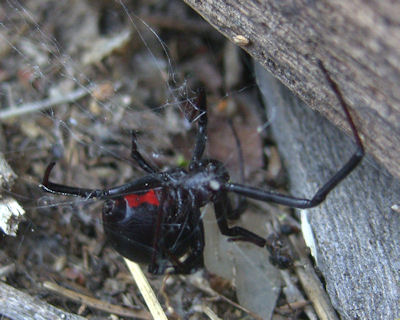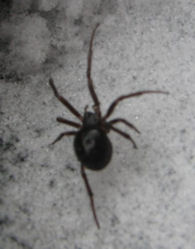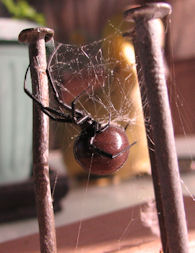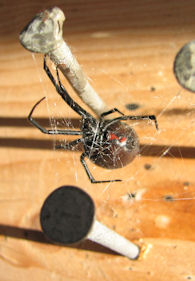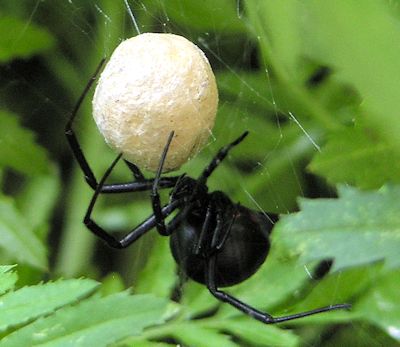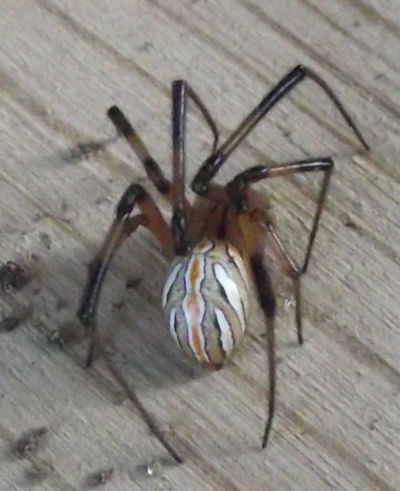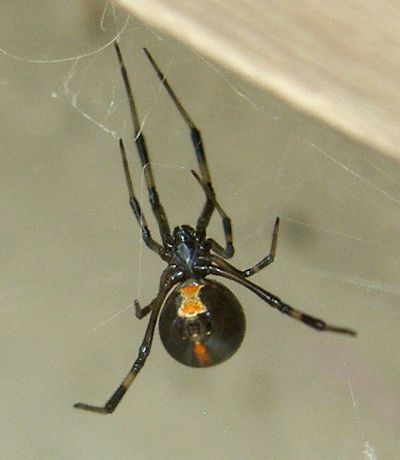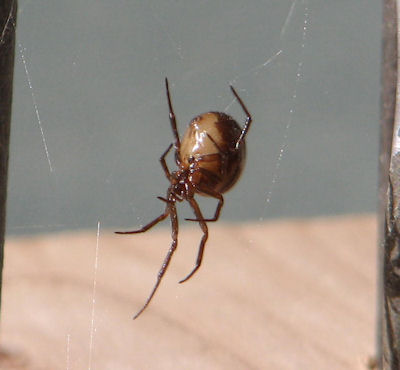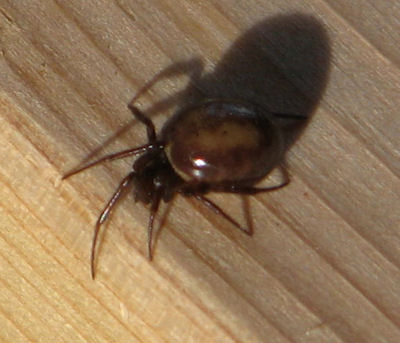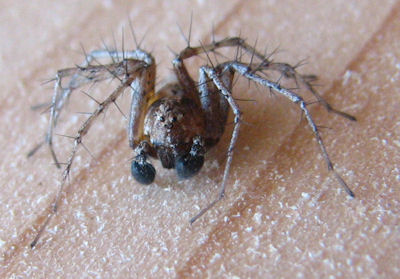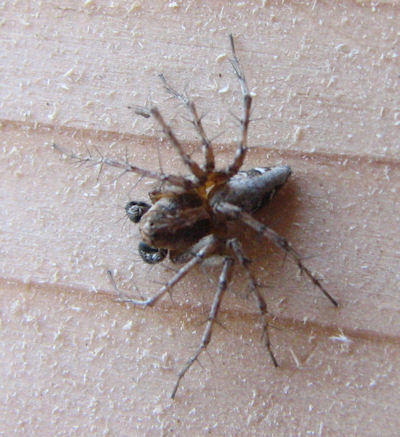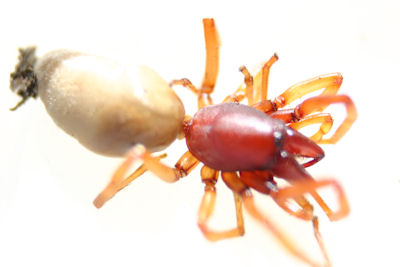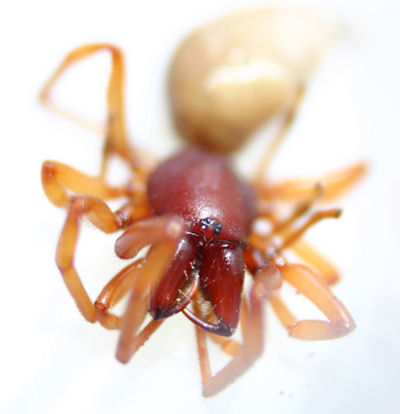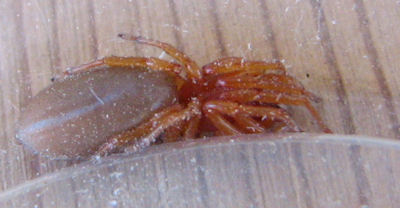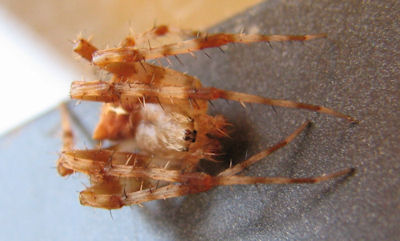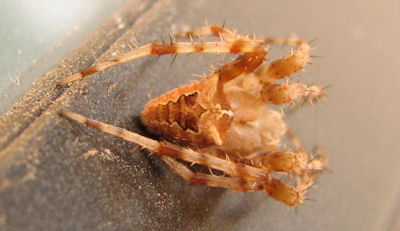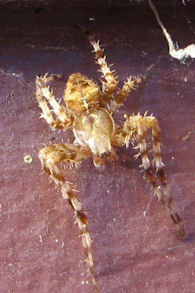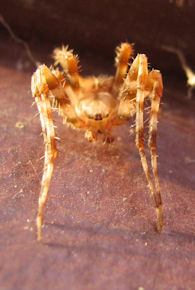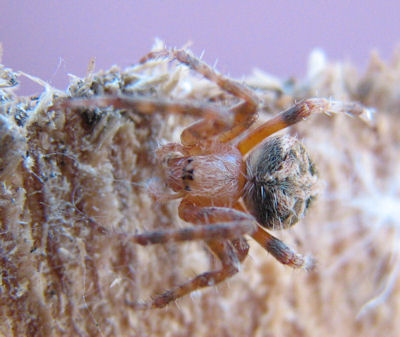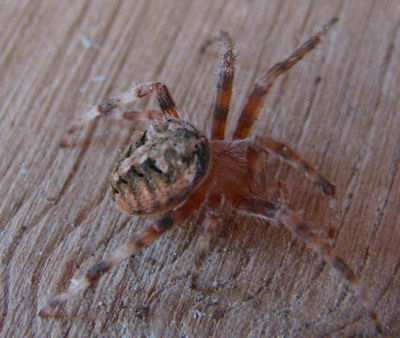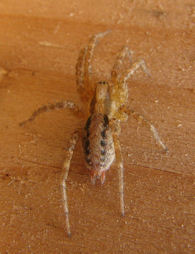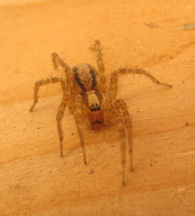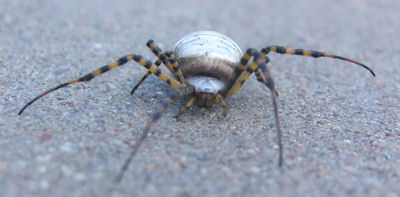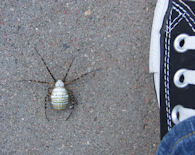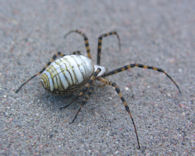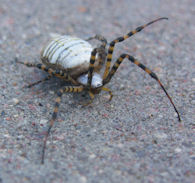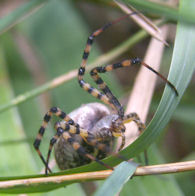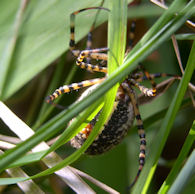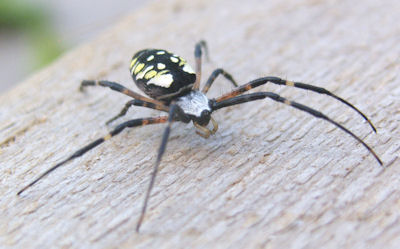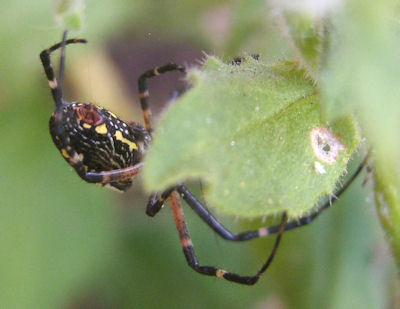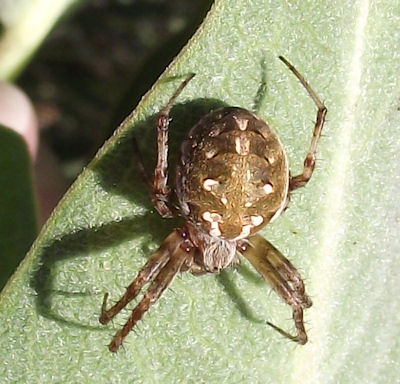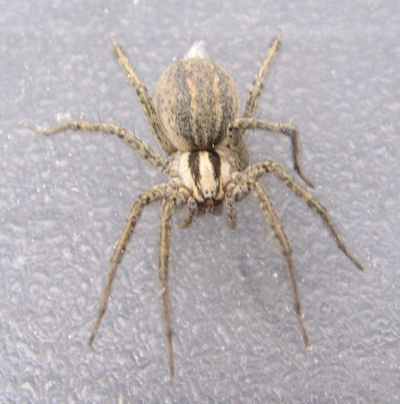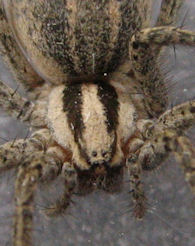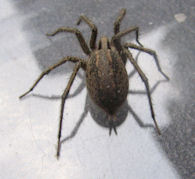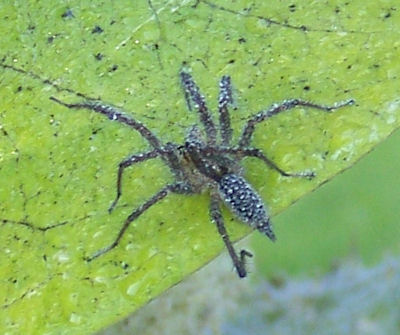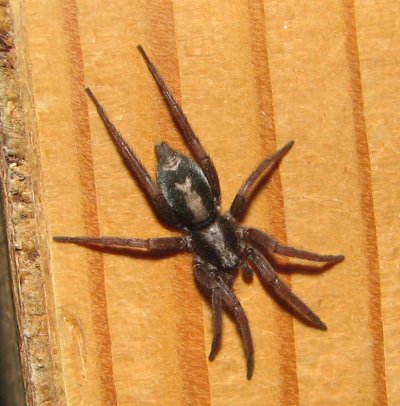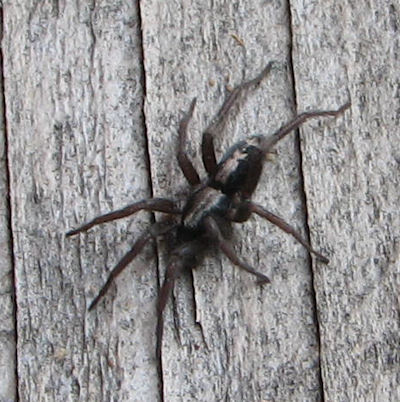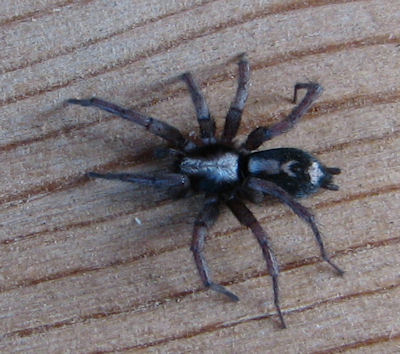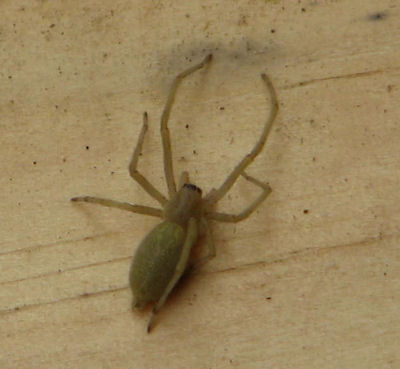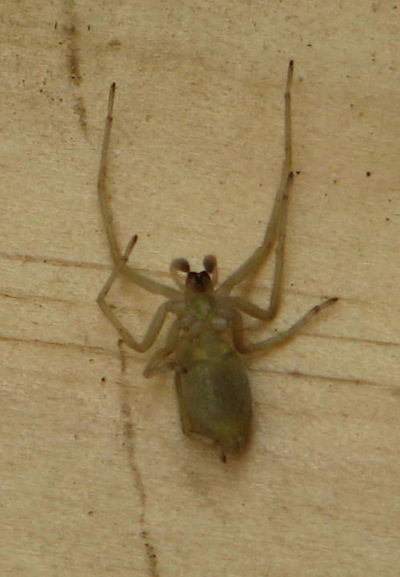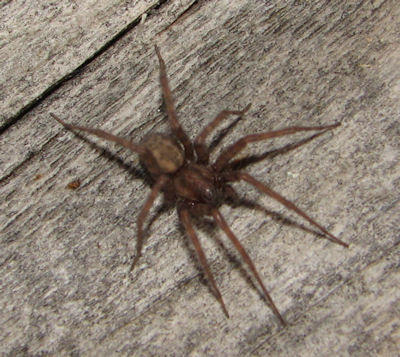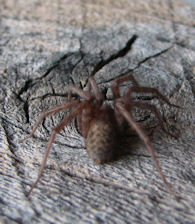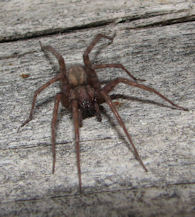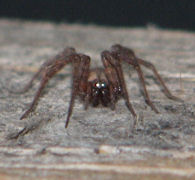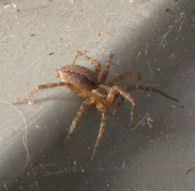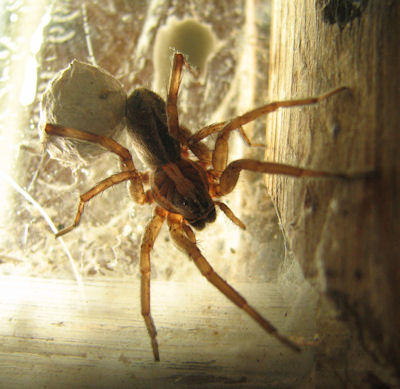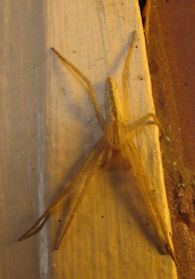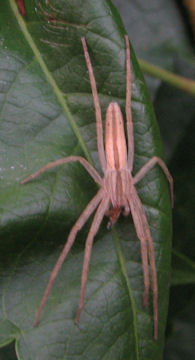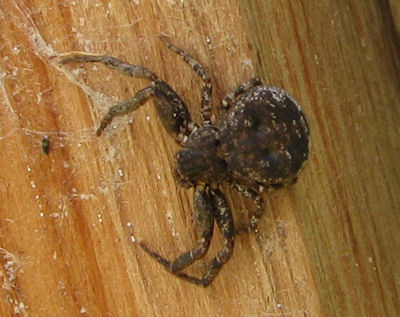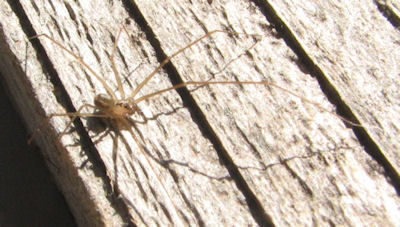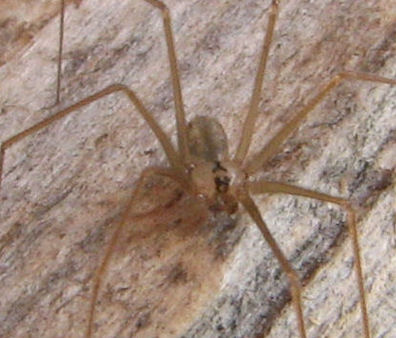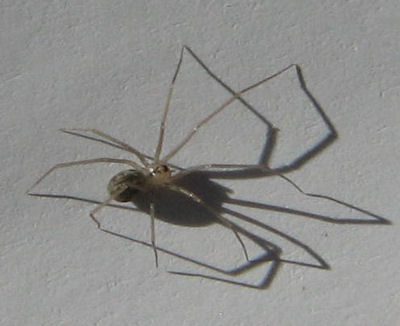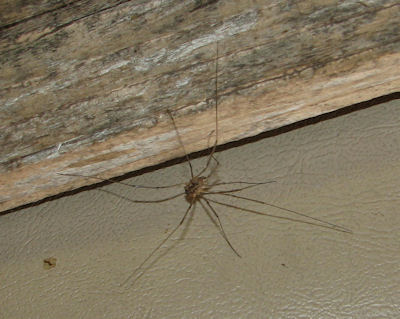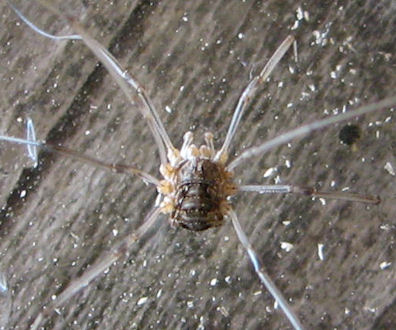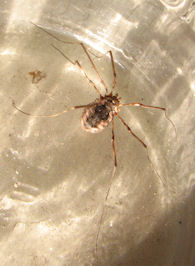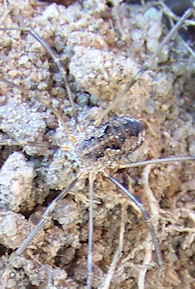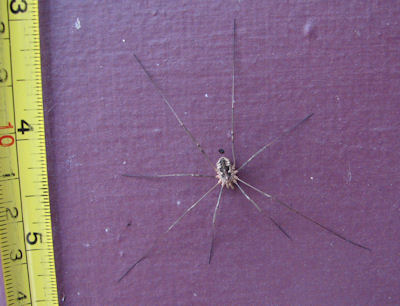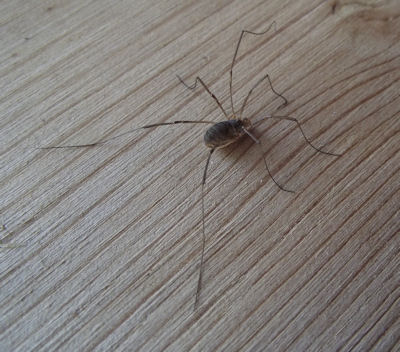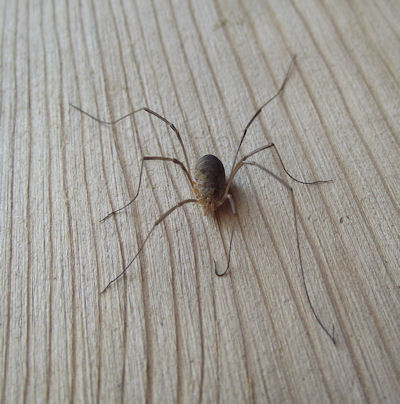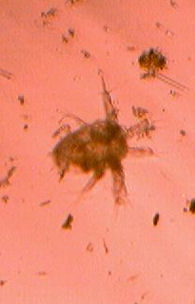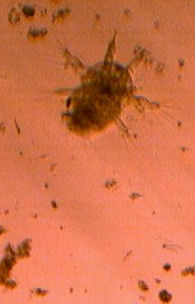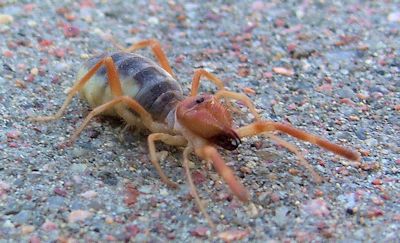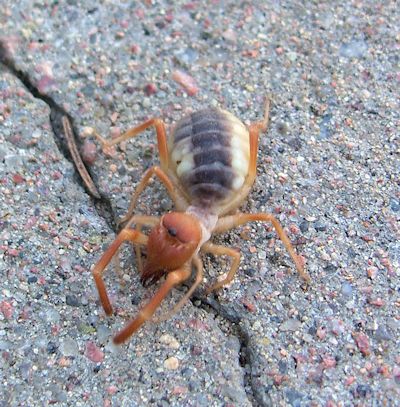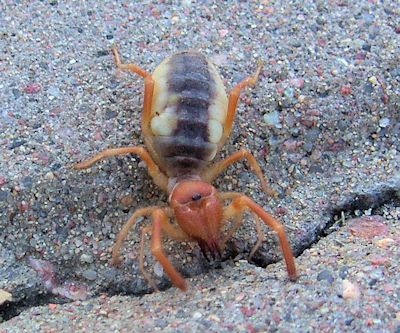Tangle-web spiders (aka cobweb spiders and comb-footed spiders), family Theridiidae
This video of a Phidippus mystaceus
(click here)
shows the typical behavior of a jumping spider.
Someone in Oklahoma named Opo Terser took this video and put it on
www.youtube.com.
Kingdom: Animalia
The second and third pictures are of another individual, probably the same species.
These pictures were taken on 19 May 2008.
This spider was about the same size, but was not quite as hairy.
The iridescent green chelicerae is found in several species within the genus Phidippus.
The meal she caught looks like an earwig, maybe a Euborellia annulipes - Ringlegged Earwig.
Kingdom: Animalia
Kingdom: Animalia
Kingdom: Animalia
Kingdom: Animalia
Pictures 2, 3 and 4: Another Zebra jumper, this one photographed on 11 September 2009.
This one was also about 3mm in size, and also needed some cooling off time in the refrigerator.
Kingdom: Animalia
According to Wikipedia, there are almost 3,000 species of Orb Weavers in over 170 genera worldwide,
making this the third largest family of spiders known (behind Salticidae and Linyphiidae).
Kingdom: Animalia
Kingdom: Animalia
Kingdom: Animalia
There are some puzzling details, especially in the second and third photos. The front appendages
appear to be holding some coiled structures. Also, the rear end has two pointed structures.
Kingdom: Animalia
Kingdom: Animalia
The photo of the eye pattern shown in the fifth photo, taken through a microscope,
was not very conclusive. I thought it was an Anyphaena maculata, but the
people at www.BugGuide.net thought otherwise.
Kingdom: Animalia
You can recognize them as crab spiders since the front pair of legs, and maybe even
the front two pair of legs, are considerably longer than the other legs. Some of
them even move sideways like a crab. If you find them around your house, don't worry.
They eat cockroaches and termites, and things that you don't want, so they are beneficial.
The pictures were taken on 1 May 2008, in El Paso Co., Colorado.
Kingdom: Animalia
Kingdom: Animalia
Kingdom: Animalia
Kingdom: Animalia
Kingdom: Animalia
Kingdom: Animalia
Kingdom: Animalia
Jumping spiders, family Salticidae
According to Wikipedia, the spiders in this family can
jump several times their body length, and also run fast.
Their eyesight is much better than the other spiders and most, if not all, insects.
They will bite if threatened, but their venom is no worse than a bee. They are predators,
and jump from ambush onto their prey. They don't make cobwebs, but can produce single
strands, used for climbing.
This is a Jumping Spider, Genus Phidippus, and
the species P. Audax. It is usually called a Bold Jumper.
There are about 75 other species in this Genus.
It lives in the space between the gate and
the fence post by my back yard. About 3/8" long.
Phylum: Arthropoda
Class: Arachnida
Order: Araneae
Family: Salticidae (Jumping spider)
Genus: Phidippus
Species: P. audax (probably)
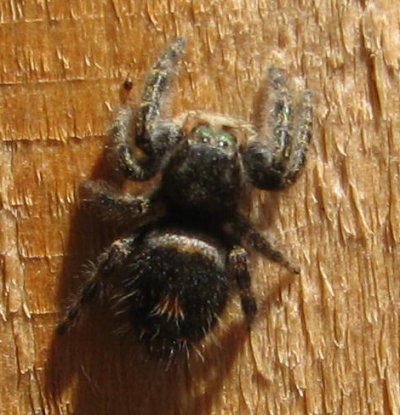
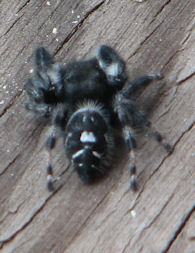
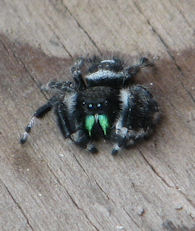
This is another Jumping Spider, Genus Phidippus, and
the species P. Audax. It was found on our kitchen ceiling on 10 April 2011.
The body length is about 1 cm.
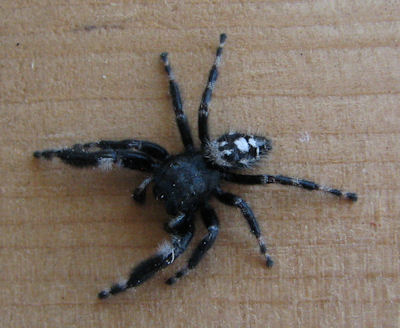
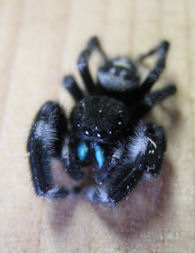
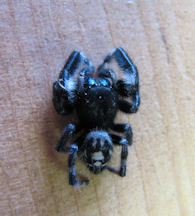
Another jumping spider.
This one is also a P. audax, but is called the bryantae variation.
This female was photographed on 17 June 2009 in Colorado Springs.
As usual, she was fairly tolerant of the camera.
During the picture taking, she noticed a small insect near it,
and promptly jumped on it and captured it, then went back to looking at me and
the camera. (second picture). This second picture also shows the green chelicerae
which covers the fangs, and is typical of the Phidippus genus. This one was large, about
1/2 inch long.
Phylum: Arthropoda
Class: Arachnida
Order: Araneae
Family: Salticidae
Subfamily: Dendryphantinae
Tribe: Dendryphantini
Genus: Phidippus
Species: audax
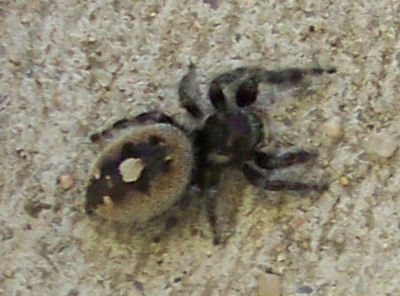
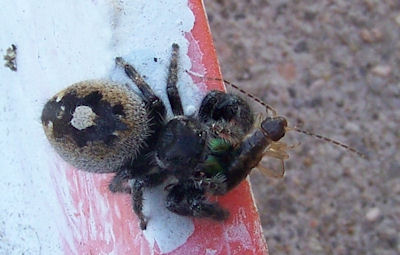
Another Phidippus Audax, of the Bryantae variation.
This one was found on my front door on 6 June 2012. It was larger than most I have
found, this female was about 1 inch in body length.
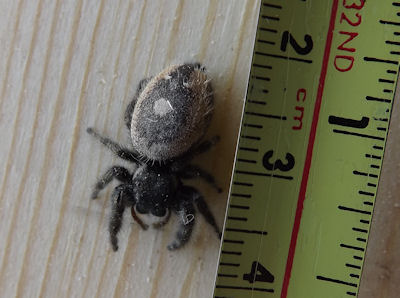
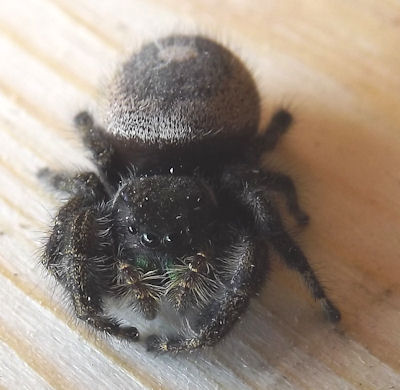
Another Phidippus, that I believe is also the audax
species. Found on my kitchen counter on 29 October 2011.
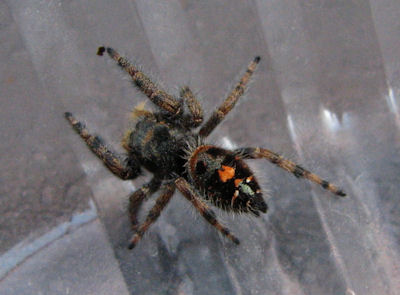
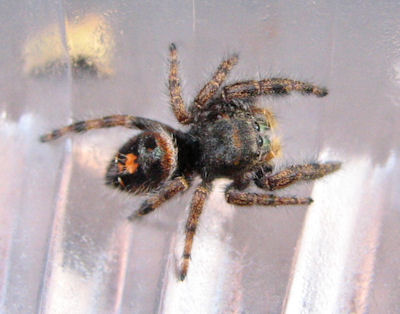
This one may also be a bryantae variation of the Phidippus
Audax, but not sure yet.
It was found on 5 September 2011 in Colorado Springs.
It was about 6mm long.
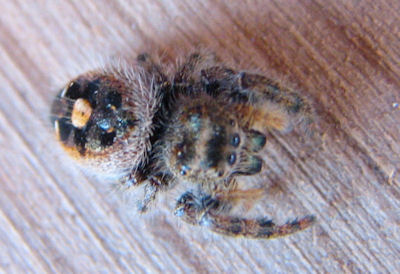
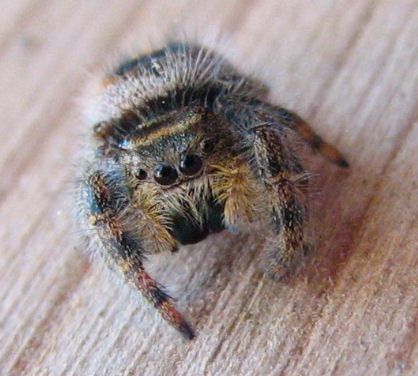
This one was found by Alyssa Erickson in August 2012 in Colorado Springs.
It is definitely the Phidippus genus, and probably the Audax species. Pictures of the top
and rear would help narrow it down.
The green covering over the fangs show up nicely here, making it for sure the Phiduppus genus.
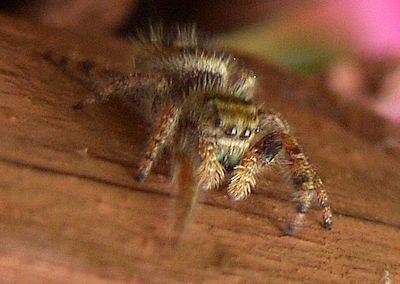
This one is also in the genus Phidippus, but this
one is the species carneus.
The pictures were taken on 9 September 2008, in Colorado Springs.
This is one of about 60 to 70 species in this genus, found mostly in North America.
This one is small, about 3mm in length.
It is probably a juvenile.
Spiders in the Phidippus genus seem to be more willing to pose for pictures than many other spiders.
Phylum: Arthropoda
Class: Arachnida
Order: Araneae
Family: Salticidae (Jumping spider)
Genus: Phidippus
Species: P. carneus
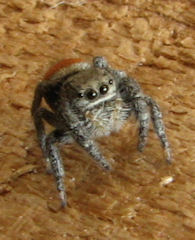
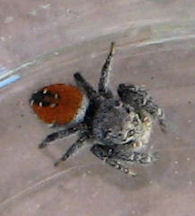
An Apache Jumper, (Phidippus apacheanus) another jumping spider in the
genus Phidippus. This small male was found in Colorado Springs on 5 September 2011.
It was about 4mm long.
Phylum: Arthropoda
Class: Arachnida
Order: Araneae
Family: Salticidae (Jumping spider)
Genus: Phidippus
Species: P. apacheanus
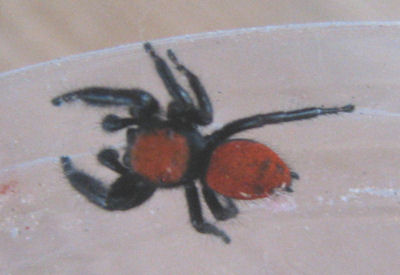
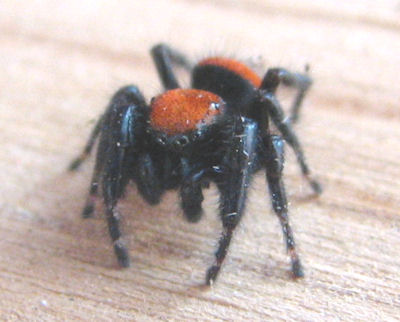
This small Jumping spider was waiting on the leaf of a Milkweed plant
near a blossom, waiting for any small insect that might be attracted to the blossom.
While I watched, the only insect that came by was a large Bumble Bee, and the spider
wisely waited for something smaller.
I found one matching photo on
http://bugguide.net/node/view/15740
that said this
is a Phidippus johnsoni, a Red-backed Jumping spider, 4th instar.
An male adult of this species would have an all red abdomen, and the female would
be red with a black stripe. This also looks like a picture of a P. clarus.
Phylum: Arthropoda
Class: Arachnida
Order: Araneae
Family: Salticidae (Jumping spider)
Genus: Phidippus
Species: P. johnsoni
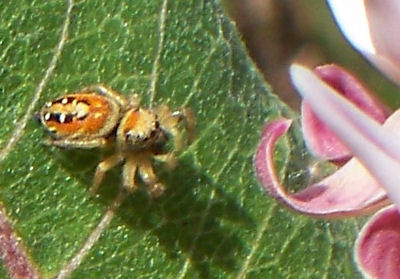
Another Jumping spider in the Phidippus genus.
It was found on a milkweed plant in the Fountain Creek Nature Center on 22 August 2009.
I have not been able to identify the species. It was on the small side,
so it may be an immature spider, which makes them harder to
identify since often, the younger ones have different color patterns
than adults.
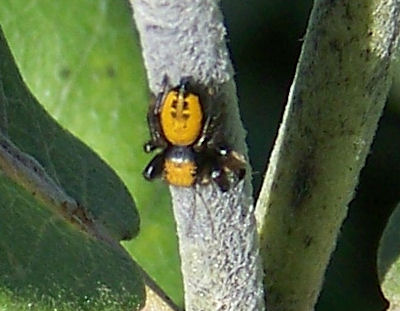
A Zebra Jumper - Salticus scenicus. Small, about 3mm in size. So fast and
ready to jump that I had to cool him off with an hour or two in my refrigerator before
I could take pictures of him. Found 15 May 2009 in Colorado Springs, CO.
Phylum: Arthropoda
Class: Arachnida
Order: Araneae
Family: Salticidae
Subfamily: Salticinae
Genus: Salticus
Species: scenicus (Zebra Jumper or Zebra Spider)
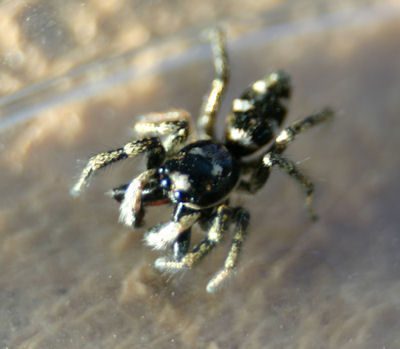
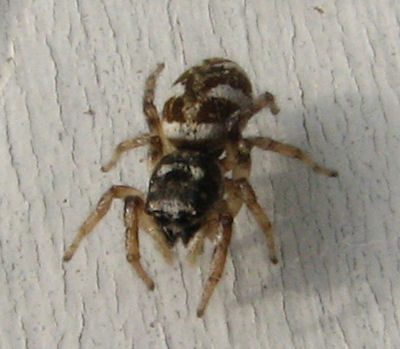
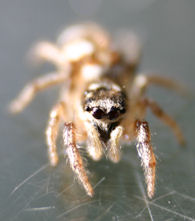
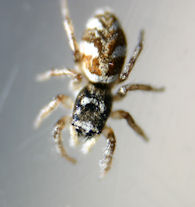
Family Oxyopidae, Lynx spiders.
Family Dysderidae, Woodlouse hunters.
Orb Weavers, family Araneidae. These spiders weave webs in a spiral pattern.
Funnel-Web spiders, family Agelenidae
All spiders are venemous, but only two species of Funnel-Web spiders
are dangerously so, and both of them live in Australia.
This is probably some species of a Grass Spider.
I could not get a good picture of it while it
was crouched back in the shadows, behind a messy looking web. This is the kind of web
that a grass spider usually weaves, a flat one with a tunnel-like place on one side to hide in.
This picture was taken 20 September 2008 at the Fountain Creek Nature Center.
Phylum: Arthropoda
Class: Arachnida
Order: Araneae
Family: Agelenidae
Genus: Agelenopsis
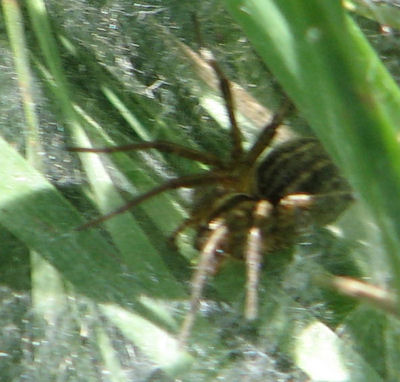
This is probably some version of a Funnel Web spider. It was on the ouside of
my garage, with it's web built near a small light bulb which burns 24/7. The web looks
like the webs that Funnel Web spiders build. These pictures were taken in Colorado Springs on 18 November 2008.
Some species within this genera have bites that are considered medically significant, but I don't know
which species this one is.
Phylum: Arthropoda
Class: Arachnida
Order: Araneae
Family: Agelenidae
Genus: Tegenaria (Funnel Web spiders)
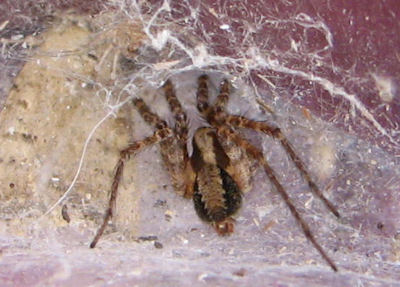
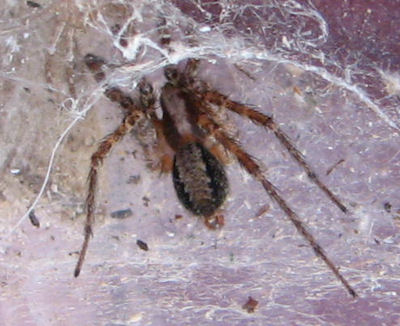
This male is probably in the genus Agelenid, in the family of Funnel Web Spiders.
It was captured on the floor of our den on 7 December 2008. It is 1 cm long, not
counting legs. One leg was lost in the capture process.
Phylum: Arthropoda
Class: Arachnida
Order: Araneae
Family: Agelenidae
Genus: Agelnid
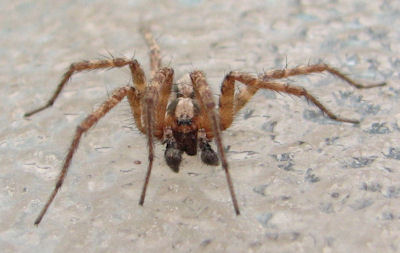
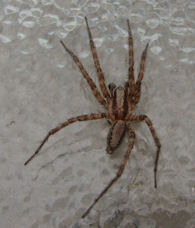
The experts on
bugguide.net/node/view/452519/bgimage say this is a grass spider.
It was found on 6 September 2010 in Colorado Springs, on our kitchen floor.
The body length was 1.5cm. There are at least 13 species within this genus.
Phylum: Arthropoda
Class: Arachnida
Order: Araneae
Superfamily: Agelenoidea
Family: Agelenidae
Genus: Agelenopsis (grass spider)
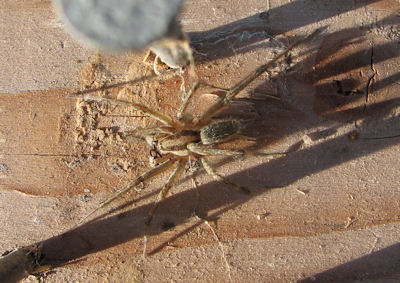
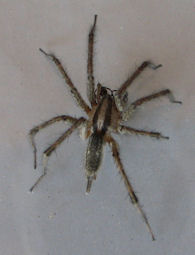
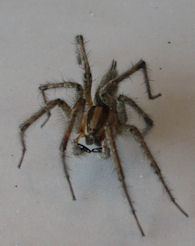
This is another Funnel Web spider. This one was caught when
I removed the screen from my Gazebo on my back patio on 6 November 2012. I was able to get a fairly good photo of the eye
arrangement, and this identified it down to the family.
Phylum: Arthropoda
Class: Arachnida
Order: Araneae
Superfamily: Agelenoidea
Family: Agelenidae
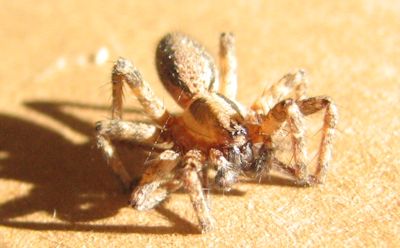
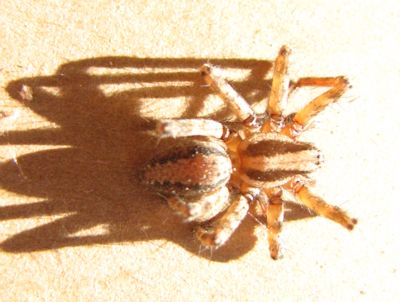
A male spider of unknown species. This was found in my garage on 1 October 2008, on the floor.
It was hard to get a good picture, since when I let it out of the jar, it would run, not walk or crawl.
It is a medium sized spider.
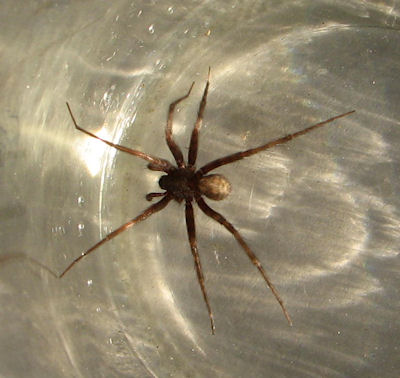
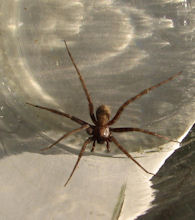
This one is a House Spider in the genus Tegenaria, specifically
a Tegenaria domestica, called the "Lesser European House Spider".
It was found in a downstairs shower on 13 August 2009, in Colorado Springs.
The first photo shows young spiders clinging to the body of
this adult. It is about 7 mm in length, not counting legs.
Phylum: Arthropoda
Class: Arachnida
Order: Araneae
Family: Agelenidae
Genus: Tegenaria
Species:
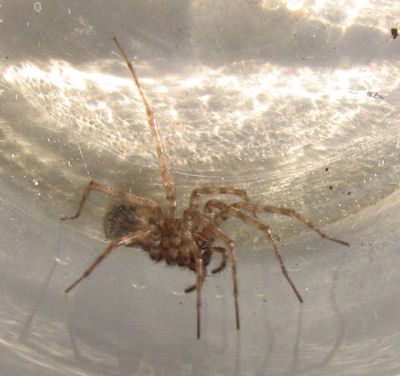
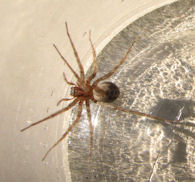
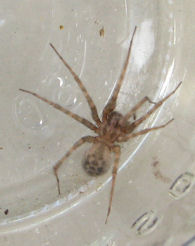
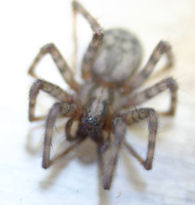
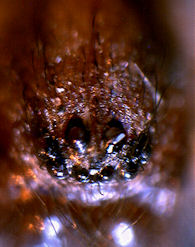
Nursery Web Spiders, family Pisauridae
Ground spiders, family Gnaphosidae
Prowling spiders, family Miturgidae
Wolf spiders, family Lycosidae
Crab spiders, family Thomisidae. There are 67 genera within this family, and many species.
This is a Crab spider,
an adult male member of the Thomisidae family.
The experts at
bugguide.net/node/view/180093
were able to narrow it down to the species.
It is 3/8" long, 5/8" wide. According to
Wikipedia, they are also commonly called "flower spiders" because they are most
often found on flowers, lying in ambush for prey.
Crab spiders do not build webs to trap prey, but are active hunters
much like the jumping spiders.
Phylum: Arthropoda
Class: Arachnida
Order: Araneae
Superfamily: Thomisoidea
Family: Thomisidae
Genus: Bassaniana
Species: utahensis
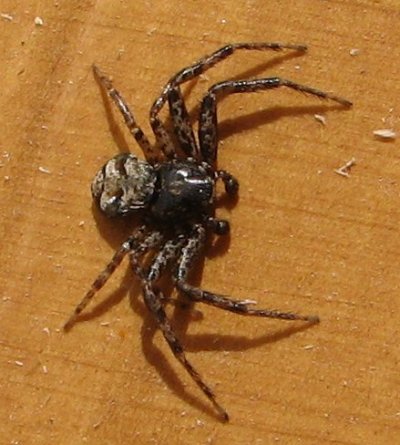
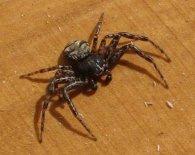
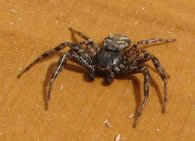
This is another crab spider. This one is a small male,
found on 9 October 2008 on my garage door in Colorado Springs.
It is about 4mm in length.
It is probably a juvenile version of the crab spider above, since
the markings are very similar.
Phylum: Arthropoda
Class: Arachnida
Order: Araneae
Superfamily: Thomisoidea
Family: Thomisidae
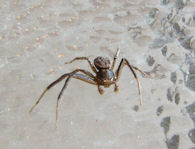
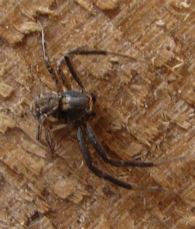
Another Crab spider. 17 May 2009 in El Paso Co., CO. About 5mm in size.
The first picture shows the eye arrangment, confirming that it is a crab spider,
and the second picture shows the color markings. Further identification has not been
made yet.
Phylum: Arthropoda
Class: Arachnida
Order: Araneae
Superfamily: Thomisoidea
Family: Thomisidae
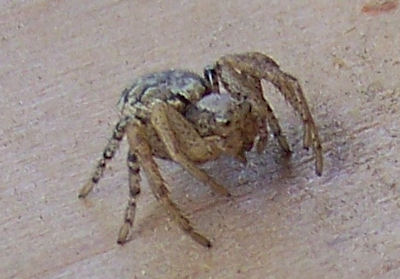
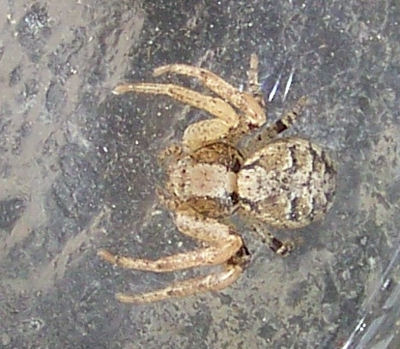
Another Crab Spider, this one a female Goldenrod crab spider.
Alyssa Erickson took this photo.
The spider is waiting on the flower for any insect to be attracted to
the flower. They do not spin webs; they just wait in ambush for their meals.
Phylum: Arthropoda
Class: Arachnida
Order: Araneae
Family: Thomisidae
Genus: Misumena
Species: M. vatia
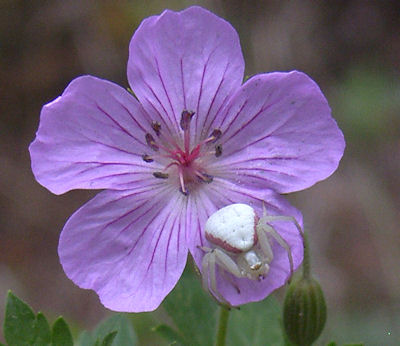
Another Crab spider, probably another Goldenrod spider. Found on 23 July 2009
in Colorado Springs, sitting on a Sunflower plant near the blossom in my flower garden. It was small,
about 5mm.
Phylum: Arthropoda
Class: Arachnida
Order: Araneae
Superfamily: Thomisoidea
Family: Thomisidae
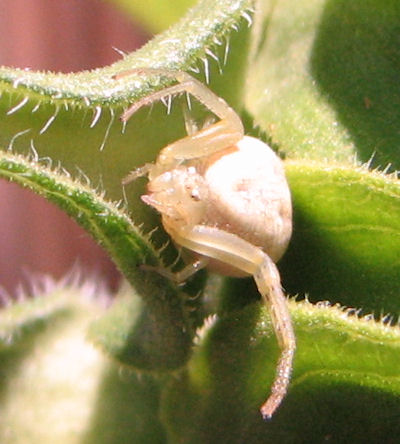
Another Crab spider, species unknown. Caught 10 May 2009 in Colorado Springs, CO.
Released on 11 May 2009. It is probably in the genus Xysticus, Ground crab spider,
but that genus is usually found in trees and bushes. This one was in a house in the
downstairs bathroom. But the color patterns fit in with the genus Xysticus better than
some of the other genus. It was about 4mm in size.
Phylum: Arthropoda
Class: Arachnida
Order: Araneae
Superfamily: Thomisoidea
Family: Thomisidae
Genus: Xysticus (probably)
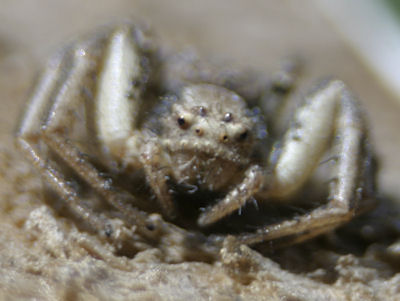
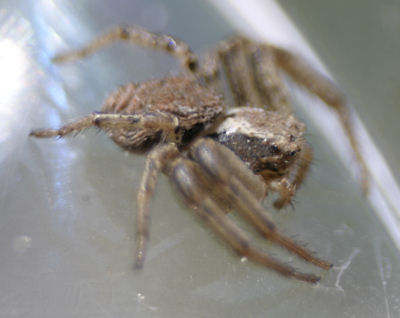
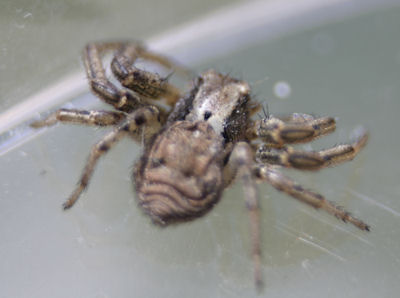
Another Crab spider, found in my kitchen sink on 29 May 2013.
It is a small male, body length about 3mm. Further identification has not been made yet.
Phylum: Arthropoda
Class: Arachnida
Order: Araneae
Superfamily: Thomisoidea
Family: Thomisidae
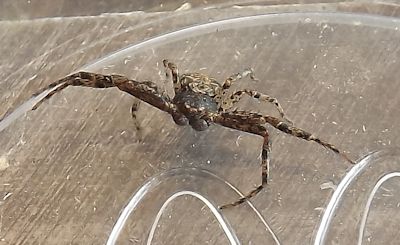
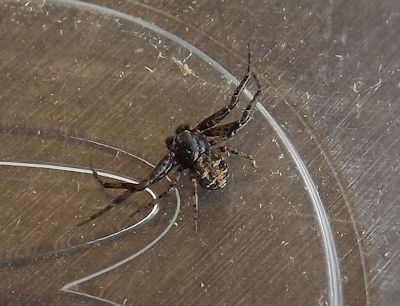
Running Crab spiders, family Philodromidae
Cellar spiders, family Pholcidae
Harvestmen, family Phalangiidae. These are not spiders.
Water mites, family Hydracarina.
Order Solifugae, Camel Spiders (not spiders)

